Country | Area 633.2 km2 | |
 | ||
Mayor Theodoros Paterakis (since 2011) | ||
Map of Sitia
Sitia (Greek: Σητεία) is a port town and a municipality in Lasithi, Crete, Greece. The town has 9,912 inhabitants (2011); the municipality has 18,318 (2011). It lies east of Agios Nikolaos and northeast of Ierapetra. Sitia port is on the Sea of Crete, part of the Aegean Sea and is one of the economic centers of the Lasithi region. European route E75, which ends in Vardø, starts in Sitia. Sitia is served by the Sitia Public Airport. Sitia has not experienced the effects of mass tourism even though there is a long beach along the road leading to Vai and several places of historical interest.
Contents
- Map of Sitia
- Sitia nature park
- Sitia airport full fpv 3
- Municipality
- Province
- Environmentally protected areas
- History
- Etymology
- Venetian Era
- Modern Era
- Infrastructure
- Health services
- Attractions
- Notable people
- References

Sitia nature park
Sitia airport full fpv 3
Municipality

The municipality Sitia was formed at the 2011 local government reform by the merger of the following 3 former municipalities, that became municipal units:
The municipality has an area of 627 km2 (242 sq mi), the municipal unit 277 km2 (107 sq mi).
Province
The province of Siteia (Greek: Επαρχία Σητείας) was one of the provinces of Lasithi. Its territory corresponded with that of the current municipality Siteia and the municipal unit Makry Gialos. It was abolished in 2006.
Environmentally protected areas
The are a number of sites in the municipality of Sitia that are protected as National Parks, Aesthetic Forests, Wildlife Refuges etc. under national and international laws. Notable examples are:
History
The earliest settlement of the town dates back to before Minoan times; excavations in the neighbouring site of Petras have unearthed architectural remains that date back to the end of the Neolithic period 3000 BC and continue throughout the Bronze Age 3000-1050 BC. In addition, there are several Minoan settlements unearthed in the various archaeological sites in the municipality, such as in Itanos and in Mochlos.
According to Diogenes Laertius, Sitia was the home of Myson of Chen, one of the Seven Sages of Greece.
Etymology
The name Σητεία may come from the ancient Ητεία, written as Itia or Etea in English.
Venetian Era
The town was later expanded and fortified by the Venetians who used it as a base of operations for the Eastern Mediterranean. During the Venetian occupation, the town was destroyed three times: by an earthquake in 1508, by a pirate attack in 1538 and finally by the Venetians themselves in 1651. Sitia was then conquered by the Ottoman Empire.
Modern Era
After the Venetians moved out of Crete, the town was abandoned for two centuries until it was resettled by farmers in 1869. The main remnant of the Venetian occupation is the Kazarma (from Italian casa di arma), the old fortress overlooking the harbour.
Infrastructure
The municipality of Sitia is served by Sitia Public Airport with several domestic destinations, the first landing was on June 7, 1984 and the airport opened officially on June 9, 1984. Construction of new building facilities that included a control tower was completed in May 1993. Runway and apron extension works were finished in May 2003. Recently (2011), the local authorities have completed negotiations with international travel agents for organizing regular charter flights starting from May 2012. Currently (2011), local officials are under negotiations with the low-cost airline Ryanair
In addition, Sitia is served by a port which connects Sitia and eastern Crete with several other Greek islands as well as with the port of Piraeus. The town also has a marina which accommodates smaller fishing boats and yachts.
Health services
The General Hospital of Sitia was founded in 1947 as a local health center and was later (1994) relocated to a new 7500sqm (110-bed capacity) building and accordingly upgraded to serve as the main hospital for the municipality of Sitia and the surrounding area.
